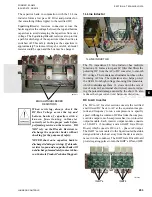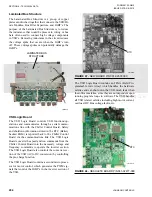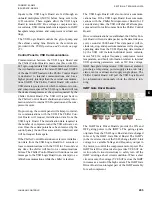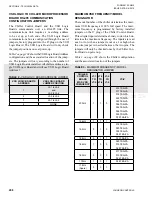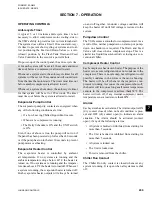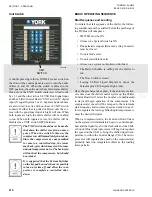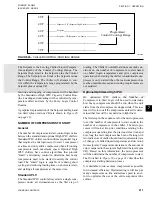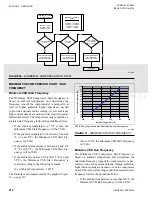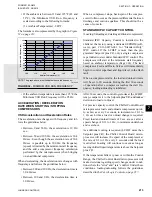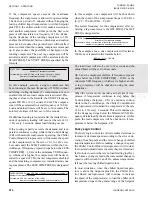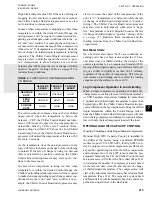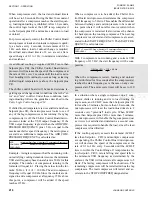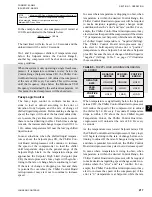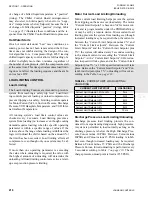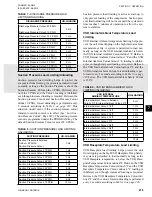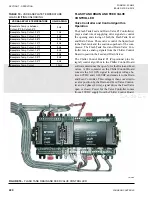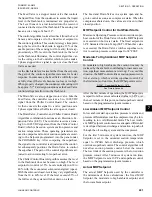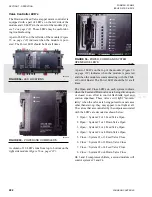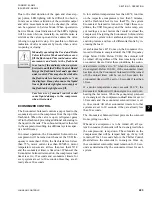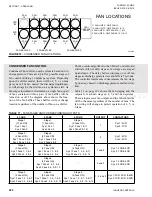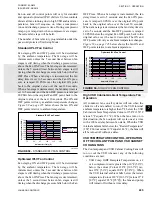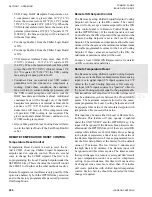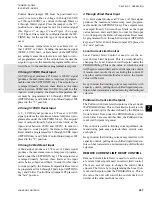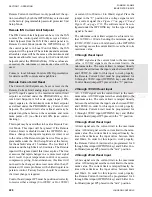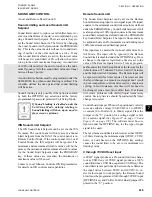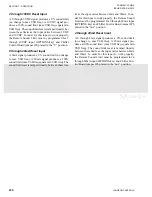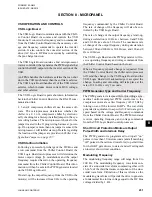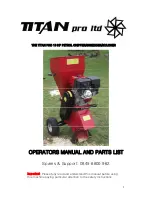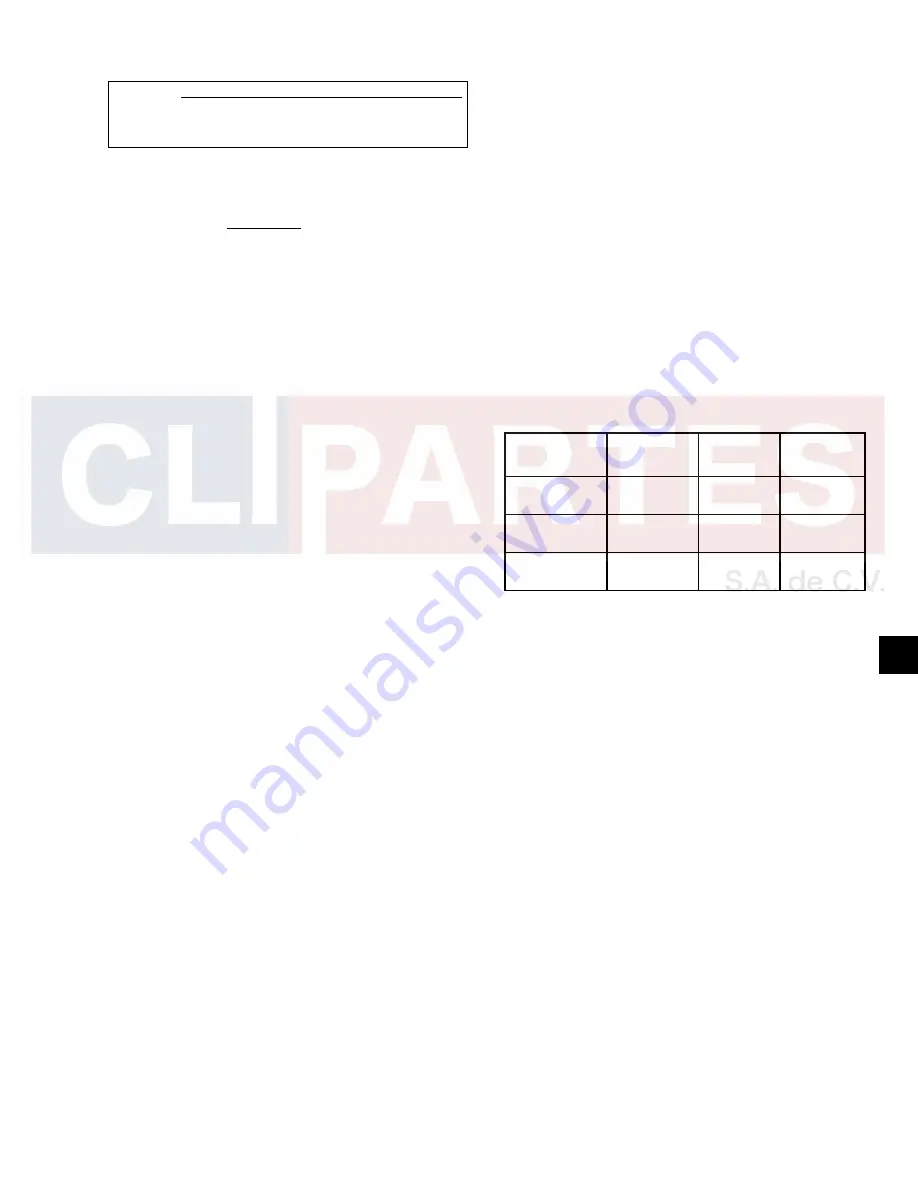
JOHNSON CONTROLS
217
SECTION 7 - OPERATION
FORM 201.23-NM2
ISSUE DATE: 3/9/2015
7
STOP = Minimum VSD Freq x (Number of Compressors R1)
COMP FREQ Number of Compressors Running
In this example: Number of compressors running = 1
Minimum VSD Freq.= 50 Hz
In the example above, one compressor will restart at
100 Hz as indicated in the formula below:
50 Hz x (1+1) = 100 Hz
1
The load timer will also be set to 30 seconds and the
unload timer will be set to 10 seconds.
On 3 and 4 compressor chillers, if temperature stays
below the Setpoint minus the Control Range/2,
another lag compressor will be shut down using the
same guidelines.
When the system is only operating a single (lead) com-
pressor, if temperature continues to stay below the
Control Range (Setpoint minus CR), the Chiller Con-
trol Board microprocessor will unload the compressor
at the rate of 1Hz every 2 seconds. This will continue
until the frequency drops below the Minimum VSD
Frequency determined by the ambient temperature. At
this point, the lead compressor will be shut down.
Fuzzy Logic Control
The fuzzy logic control in software makes deci-
sions to load or unload according to the error or
deviation from Setpoint, and the rate of change of
chilled liquid temperature. Before making a change in
speed, the logic will look at the load and unload tim-
ers to assure they are timed out. It also looks to assure
there is no load limiting in effect. Each time a change
is made, the incremental change in speed is still 0.1 to
1 Hz, unless temperatures fall near the leaving chilled
liquid cutout.
In most situations, when the chilled liquid tempera-
ture is above the Setpoint plus CR, the Chiller Con-
trol Board microprocessor will continue to increase
the speed of the compressor(s) to load the chiller
until temperature drops in the general range of the
Setpoint High Limit. As the temperature drops and
approaches the Setpoint High Limit (Setpoint plus
CR), the microprocessor’s fuzzy logic will begin fac-
toring in the rate of change before continuing to load.
If the rate of change is dropping too fast and there
is potential for overshoot, the Chiller Control Board
microprocessor may elect not to continue to increase
speed.
In cases where temperature is dropping too fast, when
temperature is within the desired Control Range, the
Chiller Control Board microprocessor will be required
to make decisions regarding speed changes under
conditions where the “error” and “rate” conflict. For ex-
ample, the Chiller Control Board microprocessor may
elect to reduce the speed of the compressor(s) if the error is
“0” (temperature is at Setpoint); while the rate of change
of chilled liquid temperature is “negative“(falling).
The Chiller Control Board microprocessor may
also elect to hold capacity when error is “positive”
(temperature is above Setpoint, but not above Setpoint
plus CR) because the rate of change of chilled liquid is
“negative” (falling).
these conditions.
TABLE 5 -
FUZZY LOGIC LOADING/UNLOADING
VS. ERROR
NEGATIVE
ERROR
ZERO ER-
ROR
POSITIVE
ERROR
NEGATIVE
RATE
UNLOAD
UNLOAD
HOLD
ZERO
RATE
UNLOAD
HOLD
HOLD
POSITIVE
RATE
HOLD
LOAD
LOAD
When temperature is significantly below the Setpoint
minus CR/2, the Chiller Control Board microprocessor
will reduce the speed of the compressor(s) to unload
the chiller by 2.0 Hz every 2 seconds. If temperature
drops to within 1.0°F above the Low Chilled Liquid
Temperature Cutout, the Chiller Control Board mi-
croprocessor will unload at the rate of 4.0 Hz every
2 seconds.
As the temperature rises toward Setpoint minus CR,
the Chiller Control Board microprocessor’s fuzzy logic
will begin factoring in the rate of change before con-
tinuing to unload. If the rate of change is rising too fast
and there is potential for overshoot, the Chiller Control
Board microprocessor may elect not to decrease speed.
In cases where temperature is rising too fast, when
temperature is within the desired Control Range, the
Chiller Control Board microprocessor will be required
to make decisions regarding speed changes under con-
ditions where the “error” and “rate” conflict. For ex-
ample, the Chiller Control Board microprocessor may
elect to increase the speed of the compressor(s) if the
error is “0” (temperature is at Setpoint), while the rate
Summary of Contents for YCIV0157
Page 38: ...JOHNSON CONTROLS 38 FORM 201 23 NM2 ISSUE DATE 3 9 2015 THIS PAGE INTENTIONALLY LEFT BLANK ...
Page 42: ...JOHNSON CONTROLS 42 FORM 201 23 NM2 ISSUE DATE 3 9 2015 THIS PAGE INTENTIONALLY LEFT BLANK ...
Page 50: ...JOHNSON CONTROLS 50 FORM 201 23 NM2 ISSUE DATE 3 9 2015 THIS PAGE INTENTIONALLY LEFT BLANK ...
Page 333: ...JOHNSON CONTROLS 333 FORM 201 23 NM2 ISSUE DATE 3 9 2015 NOTES ...

